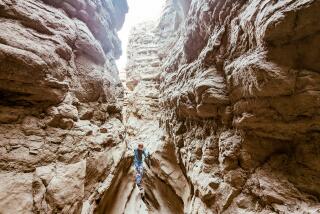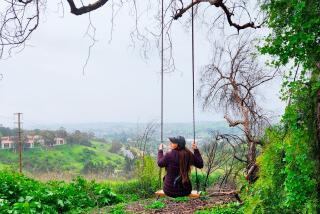Berkshires Not Limited to the Arts
- Share via
The Berkshires have as much of a cultural identity as a geographic one. These hills exist in the regional and national consciousness as surely as they do on the ground in western Massachusetts. Year-round recreation, plus a host of music and performing arts events, draw visitors from Boston and New York, from around the Northeast and from across the nation. And legions of leaf-peepers come to admire the Berkshires’ brilliant fall colors.
Showy though the hills may be, the Berkshires are much more than just a pretty backdrop for the arts. Without a doubt they are southern New England’s most rugged mountains, containing untamed brooks and rivers, rare wildlife, even some recently discovered old-growth forests.
Part of the Appalachian Mountain Range complex, the Berkshires share a name with Berkshire County. The hills are bordered by the Connecticut River Valley and its tributaries to the east and the Hudson River to the west.
Because the Berkshires’ farming and industrial eras came and went so long ago, the land has had a century and a half to recover. Thus today’s visitors admire substantial second-growth forests, and clear-running brooks and rivers.
Mt. Greylock
Mt. Greylock’s sheer size commands respect. Its broad, open summit stands 3,487 feet tall, making it the highest peak in all of southern New England. The 100-mile panoramic views from the summit take in much of western Massachusetts, plus glimpses of four more states: Vermont’s Green Mountains, New Hampshire’s White Mountains, and mountain ranges in Connecticut and New York.
Mt. Greylock offers about 45 miles of footpaths, including a memorable stretch of the Appalachian Trail. The 14,000-acre Greylock Reserve encompassing Mt. Greylock and an additional half a dozen substantial summits is one of the state’s largest and, in the opinion of many hikers, offers the very best hiking.
The mountain’s height, along with its cool, damp weather, means Greylock’s upper slopes support plant life not found at lower elevations.
Up top, the hiker is unlikely to be alone with the stunted balsam fir and the 180-foot-high War Memorial tower built after World War II to honor state residents slain in the war. A road leads to the summit, the location of the Appalachian Mountain Club’s Bascom lodge, which offers food service, guided walks, and trail and weather information. Its handsome stone building was constructed by the Civilian Conservation Corps in the 1930s out of Greylock’s rock and native spruce.
Many Berkshires walkers consider the route through “the Hopper” the classic ascent of the mountain. The Hopper is a glacial cirque, where steeply pitched slopes are cloaked with conifers and hardwoods. Early farmers thought the circle-shaped valley resembled a grain hopper. (More industrially inclined locals believed it resembled a coal hopper.)
Whatever the inspiration for its name, the Hopper today is an official National Natural Landmark. The historic trail through it has been the favored jaunt of Williams College students since the 1830s.
Soon leaving behind fields and the Money Brook Trail, Hopper Trail climbs steeply through beech and maple woodland. At the 2.2-mile mark, the path reaches Sperry Campground. From the camp’s information kiosk, Hopper Trail continues climbing on a worn and rocky trail, crosses Overlook Trail and junctions with the Appalachian Trail 3.5 miles from the trail head. The AT climbs steeply 0.5-mile to Memorial Tower.
Access: From Massachusetts 43, 2.5 miles south of Williamstown, turn south on Hopper Road. Drive a mile, then bear left on a gravel road. Proceed half a mile more to a parking area and the signed trail head at road’s end.
Money Brook
For an easier Greylock ramble, try the one-mile-round-trip jaunt to Money Brook Falls or a loop via Mt. Prospect (four miles round trip with a 1,400-foot elevation gain).
As the story goes, Money Brook was named for a band of counterfeiters who stashed the highly illegal tools of their trade in a cave. Some colorful local tales describe late 1700s counterfeiters who stamped out coinage.
A blue triangle-blazed path descends briefly to Money Brook Trail. (Turn left for a quick jaunt to Money Brook Falls.) Loop trip hikers bear right, passing a trail-side camping shelter and soon joining white triangle-blazed Appalachian Trail. After a brief walk on the AT, you’ll junction with the blue-blazed Mt. Prospect Trail and turn south. Grand westward vistas are the hiker’s reward for the ascent of Mt. Prospect.
On the descent from Prospect, the trail offers great views of Mt. Greylock. Intersecting Money Brook Trail, you’ll head left, soon leaving Money Brook behind as you ascend the steep shoulder of Mt. Prospect. A side trail leads 0.1 mile to Money Brook Falls, a 50-footer with a series of cascades. Return to Money Brook Trail and follow the path on its short, final ascent back to the trail head.
Access: From the top of Mt. Greylock, descend three miles north on Notch Road to a small parking area and signed trail on the west side of the road. Or, from Massachusetts 2 in North Adams, turn south on Notch Road and proceed five miles to the parking area.
(BEGIN TEXT OF INFOBOX / INFOGRAPHIC)
Hopper, Money Brook Trails
Where: Mt. Greylock State Reservation.
Distance: To Mt. Greylock summit is 8 miles round trip with 2,300-foot elevation gain.
Terrain: Highest peaks in southern New England, fir and spruce forest.
Highlights: Brilliant fall color, 100-mile panoramic views.
Degree of Difficulty: Moderate to strenuous.
For More Information: Mt. Greylock State Reservation, Massachusetts Division of Forests and Parks, East St., Mt. Washington, MA 01258, tel; (413) 4262.
More to Read
Sign up for The Wild
We’ll help you find the best places to hike, bike and run, as well as the perfect silent spots for meditation and yoga.
You may occasionally receive promotional content from the Los Angeles Times.






